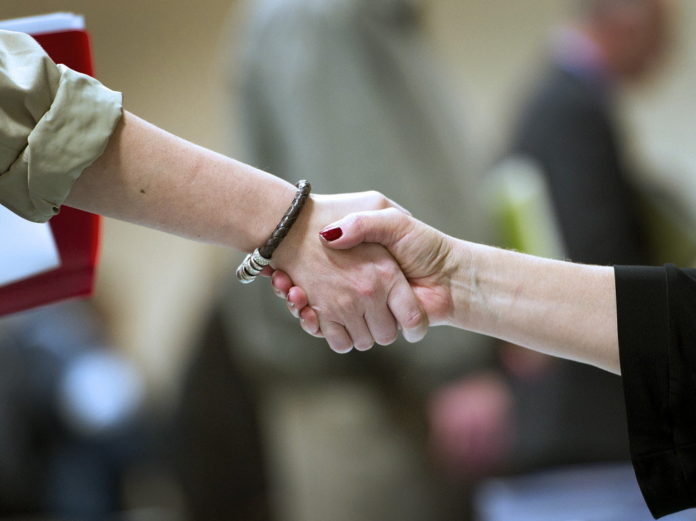
WASHINGTON – The number of Americans seeking unemployment benefits dropped last week to the lowest level in almost four years, adding to evidence of an improving U.S. labor market.
Initial jobless claims fell 5,000 in the week ended March 24 to 359,000, the lowest since April 2008, the Labor Department reported Thursday in Washington. The median forecast of economists in a Bloomberg News survey called for 350,000 claims. With the report, the government data also contain revisions dating back to 2007.
Companies are retaining workers and hiring as sales pick up along with confidence in the expansion. The pace of employment has gained momentum in the past three months, helping drive income growth that may ease the strain of higher gasoline prices.
“The labor market is still improving at a modest pace,” said Russell Price, senior economist at Ameriprise Financial Inc. in Detroit. “Across almost all sectors, companies have shed as many workers as they possibly can. Now, they’re responding to the modest improvements in demand.”
The number of people on unemployment benefit rolls dropped to the lowest level since August 2008, while those getting extended payments also decreased.
Stock-index futures held earlier losses after the report. The contract on the Standard & Poor’s 500 Index maturing in June fell 0.4 percent to 1,394.6 at 8:35 a.m. in New York.
Profit Growth Cools
The economy grew at a 3 percent annual rate in the final three months of 2011, the Commerce Department said today. The data also showed corporate profits climbed at the slowest pace in three years, raising the risk that business investment and hiring will cool.
Estimates of the 46 economists surveyed by Bloomberg for initial claims ranged from 341,000 to 360,000. The Labor Department revised the previous week’s figure to 364,000 from an initially reported 348,000.
There was “nothing unusual” that affected last week’s data, a Labor Department spokesman said.
The four-week moving average, a less-volatile measure than the weekly figures, fell to 365,000 last week from 368,500.
The number of people continuing to receive jobless benefits dropped by 41,000 in the week ended March 17 to 3.34 million.
Extended Benefits
In addition to the jobless claims, the number of Americans receiving extended benefits under federal programs declined by almost 79,000 to 3.24 million in the week ended March 10.
The unemployment rate among people eligible for benefits, which tends to track the jobless rate, fell to 2.6 percent, from 2.7 percent in the prior week, today’s report showed.
Forty-two states and territories reported a decline in claims, while 11 reported an increase. These data are reported with a one-week lag.
The recent decrease in dismissals may soon be followed by a pickup in hiring. Chief executive officers plan to increase capital spending and hiring over the next six months as they turned more optimistic about the U.S. economy, a survey showed yesterday.
CEO Outlook
The Business Roundtable’s economic outlook index increased to 96.9 in the first quarter from 77.9 in the previous three months, the Washington-based trade group reported. Readings greater than 50 are consistent with economic expansion, and this quarter’s measure is the highest since April-June 2011.
Forty-two percent said they will increase payrolls, compared with 35 percent in the prior quarter, while 43 percent plan to hold their staffing levels steady.
“The economy is not yet growing fast enough to overcome productivity improvements and begin significant new hiring on top of that,” Jim McNerney, chief executive officer of Boeing Co., said yesterday on a conference call sponsored by the Business Roundtable, a Washington association of chief executives. “We’re still in this awkward growth phase. It’s heartening that we’re growing, but it’s not enough.”
The U.S. jobless rate could drop to as low as 6 percent by the first half of 2013, according to research from the Federal Reserve Bank of New York.
The relationship between the number of Americans newly unemployed and those recently finding work indicates joblessness will continue to decline, according to economist Aysegul Sahin. The jobless rate held at a three-year low of 8.3 percent last month after falling by 0.8 percentage point in the year ended January, according to figures from the Labor Department.
New York Fed Study
“Simulations based on historical patterns suggest that the fall in the unemployment rate could be quicker than many forecasters predict,” Sahin wrote in a note on the bank’s Liberty Street Economics blog co-written by research associate Christina Patterson.
Fed Chairman Ben S. Bernanke said while he’s encouraged by the unemployment rate’s decline, continued accommodative monetary policy will be needed to make further progress.
“A wide range of indicators suggests that the job market has been improving, which is a welcome development indeed,” Bernanke said March 26 to the National Association for Business Economics.
“Still, conditions remain far from normal, as shown, for example, by the high level of long-term unemployment and the fact that jobs and hours worked remain well below pre-crisis peaks, even without adjusting for growth in the labor force,” he said.












